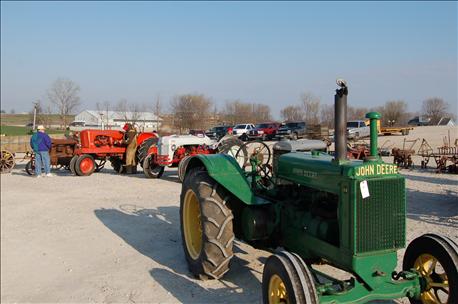
Dan Gwin has a knack for finding and buying items at auctions or by word-of-mouth that later become useful pieces for a project. Maybe he’s working on his grain system and comes across a used leg or other component at a low price. He’s so good at it, we wrote a story about it.
But Gwin also has another valuable instinct: knowing when something cheap is worn-out or isn’t something he can use. That means he knows when junk is, well, junk!
Not everyone has that instinct, starting with me. Here are three things I’ve drug home, thinking I had a bargain. Sometimes bargains turn out to be expensive.
1. The old riding mower that would save me hundreds!

BARGAIN OR JUNK? Is there a bargain in this auction line or just junk? If there’s any junk, I would not only find it, I would drag it home!
When we moved to where we live now, I needed a riding mower. A friend had one parked in his barn because it needed a "little work." It looked like a steal to me. I bugged him until he sold it to me for $500. I took it straight to a mechanic to get that "little work" done. The mechanic told me the motor was "soft" and charged me $250. I mowed two rounds and kaboom! That was it! The motor was shot. So I sold it to an acquaintance for $100. Net on that deal — about $650 in the hole, plus frustration and a little pride.
2. A good riding mower that would save me thousands!
Another friend was helping me shop for a mower several years later, after I had checked out a couple of big-box store models. Compared to a new one, I could save thousands on this brand-name mower a buddy of his just happened to have. He got it from a lady who needed cash. I should have known right then to stop, but I bought it anyway. The person who mowed with it first made half a round, forgot it was a hydrostat transmission, and drove into the corner fence brace post. A cracked hood on a green lawn tractor was $500. I spent $40 just on a manual. The next season it started shaking, and no one could figure it out. It shook so badly the bolts holding the engine onto the frame worked loose. Long story short, I traded for a new one, losing about $800. Total cost: $500 plus $40 plus $800 equals $1,340, a lot of frustration and more pride.
3. A lawn tractor with a snow blade so I didn’t have to hire my driveway plowed!
I borrowed a neighbor’s pickup to go 150 miles to get this one. It was a bargain-brand rider, but it had a blade and snow chains. I could see myself barreling down the driveway, snow flying.
Next winter the snow came. I had the blade hooked up beforehand. When I went to put on the snow chains, they didn’t fit quite right. I thought I had them on, headed out the garage door with it, and went 5 feet. All that went flying were the chains. I tried again with the same result. After an hour, I kept the chains on long enough to clean a path through the driveway. Both the chains and mower soon found a new home. Cost on that one: about $800, plus some mighty frozen fingers and another big dose of pride.
Do you see a pattern here? Last summer I bought a mower brand-new, from a machinery dealer. Dan, maybe you should write a book on how to find bargains and not junk!
About the Author(s)
You May Also Like




